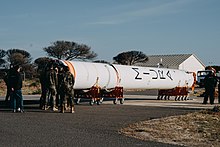Miura Next
| Function | partially reusable orbital launch vehicle |
|---|---|
| Manufacturer | PLD Space |
| Country of origin | Spain |
| Size | |
| Height | 60 m (200 ft)[1] |
| Diameter | 3.5 m (11 ft)[1] |
| Stages | 2 |
| Capacity | |
| Payload to Low Earth orbit (LEO) | |
| Mass | 13,580 kg (29,940 lb)[1] |
| Payload to SSO | |
| Mass | 11,275 kg (24,855 lb)[1] |
| Payload to GTO | |
| Mass | 4,595 kg (10,130 lb)[1] |
| Launch history | |
| Status | Under development |
| Launch sites | Guiana Space Centre (planned) |
| First flight | Planned for 2030 |
| First stage | |
| Diameter | 3.5 m (11 ft) |
| Powered by | 5 |
| Maximum thrust | 5,530 kN (1,240,000 lbf) |
| Propellant | LOX / RP-1 |
| Second stage | |
| Powered by | 1 |
| Propellant | LOX / RP-1 |
The Miura Next is a future reusable heavy-lift rocket currently in development, part of PLD Space's program for the next 20 years. Designed to compete in the market of reusable launchers, it will allow for the transport of large payloads to low Earth orbits and beyond. With capabilities for crewed missions and reusable first stages, it aims to position itself as a European alternative to rockets like the Falcon 9. It is expected to work alongside the crewed capsule Lince, expanding the capabilities for space exploration and commercial ventures.[2]
Description
The rocket was introduced by PLD Space in October 2024 as part of their space program for the next two decades. The company, headquartered in Elche, Spain, revealed their new reusable heavy-lift rocket during an event that showcased their commitment to innovation and competitiveness in the global launch market, targeting the first half of the 2030s for its maiden flight.[3]

Both the rocket and the crewed capsule Lince were developed in secrecy by the company until their development was made public during an event marking the anniversary of the first launch of Miura 1,[4] which was expected to provide updates on the development of the Miura 5.[5]
The Miura Next will be a reusable rocket that is part of PLD Space's new family of launchers. Versions currently named Miura Next Heavy and Super Heavy will be able to place up to 53 tons into low Earth orbit. Additionally, they will be capable of carrying between 2.4 and 16 tons to the Moon and Mars, depending on their configuration, which may include up to four booster engines that will also be reusable.[6]
The first flight is expected in 2030, and by 2035, it is projected to be one of the most powerful rockets in the world, with scalable and reusable technology. It will also be the only one of its kind within the European Union, as the company aims to establish independence for the EU in terms of space travel.[7]
Capabilities
The following table lists the expected payload capabilities for the various vehicle configurations to different destinations.
| Destination | Miura Next | Miura Next Heavy | Miura Next Super Heavy | |||
|---|---|---|---|---|---|---|
| Expendable | Reusable (barge) | Reusable (return to launch site) | Expendable | Reusable [a] | Expendable | |
| LEO (420 km) | 13,580 kg | 10,200 kg | 6,650 kg | 36,000 kg | 19,500 kg | 53,000 kg |
| SSO (500 km) | 11,275 kg | 8,300 kg | 5,130 kg | 30,580 kg | 16,250 kg | – |
| GTO | 4,595 kg | 2,900 kg | 1,100 kg | 15,140 kg | 7,160 kg | 23,000 kg |
| Moon | – | – | – | – | – | 16,695 kg |
| Mars | – | – | – | – | – | 13,660 kg |
See also
Notes
- ^ Side boosters reused. Core expended.
References
- ^ a b c d e "Beyond_ by PLD Space - English dubbed version". Youtube. PLD SPACE. Retrieved 7 October 2024.
- ^ "The Miura Next heavy-lift rocket and the manned capsule Lince: PLD Space's ambitious space program for the next twenty years". Eureka (in Spanish). 7 October 2024. Retrieved 8 October 2024.
- ^ S.L, EDICIONES PLAZA. "PLD Space exceeds Miura 5 and designs a space capsule to send astronauts to the Moon or Mars". Alicanteplaza (in Spanish). Retrieved 8 October 2024.
- ^ S.L, EDICIONES PLAZA. "Ilicitana PLD Space makes history: first flight of the 'Miura 1'". Alicanteplaza (in Spanish). Retrieved 8 October 2024.
- ^ Zavia, Matías S. (7 October 2024). "PLD Space isn't satisfied with the first Spanish rocket: it's been secretly developing a spacecraft for a year". Xataka (in Spanish). Retrieved 8 October 2024.
- ^ Erard, Gabriel (7 October 2024). "Starship beware: Spanish PLD Space announces Miura NEXT, its large reusable rockets for reaching the Moon and Mars". Hipertextual (in Spanish). Retrieved 8 October 2024.
- ^ S.L, EDICIONES PLAZA. "PLD Space exceeds Miura 5 and designs a space capsule to send astronauts to the Moon or Mars". Alicanteplaza (in Spanish). Retrieved 8 October 2024.
